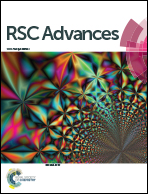The mechanistic insight into the biomilling of goethite (α-FeO(OH)) nanorods using the yeast Saccharomyces cerevisiae†
Abstract
Since the last decade, eco-friendly routes for the synthesis of nanostructured materials of various types and functionalities have been a topic of enormous interest in the field of nanotechnology. The primary work in this field started with the ‘bottom-up’ microbial synthesis of nanoparticles, however, the bioleaching potential of microbes was initially overlooked in this research. The bioleaching process is useful especially where the synthesis of particles with size < 10 nm is challenging. In the present work, the mechanistic insight of biomilling for a gradual transformation of anisotropic α-FeO(OH) rod-shaped particles into isotropic nanoparticles below 10 nm size has been explored using detailed UV-vis spectroscopy, transmission electron microscopy, atomic force microscopy, X-ray diffraction, and X-ray photoelectron spectroscopic studies which suggest that the aquo group present at the α-FeO(OH) surface may provide the site for interaction with carboxyl ions of protein molecules which results in the formation of a stable coordination compound with Fe3+ ions. This will create a new Fe3+ ion on the surface of the lattice which leads to the repetition of the process of protein complexation with Fe3+ ions and dissociation of the complex from the lattice that causes the fragmentation of bigger nanoparticles into protein functionalized smaller nanoparticles.


 Please wait while we load your content...
Please wait while we load your content...